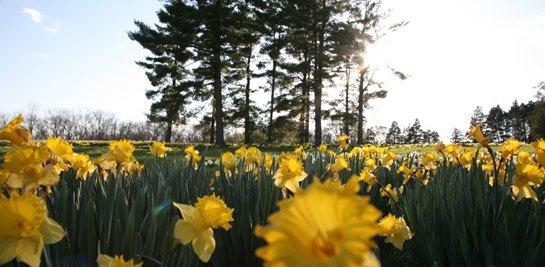


Visit to Shaw Nature Reserve
The Missouri Botanical Garden’s land purchase in 1925 began the legacy of Shaw Nature Reserve. Originally set up as a safe refuge for the plant collection from the city’s smoke pollution of the 1920’s, its role in the community has evolved through the years. Shaw Nature Reserve has many roles—as a nature reserve, a place to walk and hike, and a good spot for relaxing and for studying nature. It has become a premier educational, research and habitat restoration and reconstruction site. St. Louis is one of very few metropolitan regions that can boast of a 2,441-acre natural asset such as Shaw Nature Reserve so near its city-based parent organization, the world-famous Missouri Botanical Garden.
"But what about the daffodils", you ask?
There are likely millions of daffodils blooming around the Shaw Nature Reserve's Pinetum Lake and the one-mile road encircling it beginning in late March/early April each year, and beyond into the Reserve. Many varieties of Narcissi have been accumulating around the Pinetum Lake for the biggest part of the 88 years the Reserve has been in existence.
Daffodils got their start at the Nature Reserve through the efforts of Mr. John Howe who lived and farmed close to the town of Pacific, Missouri. He was an amateur propagator of daffodils as well as of nuts, fruits, vegetables, and other flowering bulbs. Mr. Howe brought a bushel of daffodil bulbs to the Reserve to share during its fledgling years when the earliest planting was being done. Upon seeing Mr. Howe's basket of bulbs, Dr. Edgar Anderson, then Curator of Useful Plants at Missouri Botanical Garden, wanted to know who produced these masterpieces of horticulture.
Dr. Anderson was especially fond of daffodils and devoted much time and energy to both the Botanical Garden's and the Shaw Nature Reserve's collections. At regular intervals after Mr. Howe's bulbs were first put in place, hundreds of additional varieties from the newest to the classic standards of the day were planted. The plantings were carefully studied, especially during the period 1938 and 1942. The goal was to have a continuous display of color lasting for a full two months using a mixture of early to late blooming varieties.

Support our
Convention!
The mission of the American Daffodil Society, our National organization, is to be an internationally recognized not-for-profit association of individuals, organizations, companies, and/or universities dedicated to the encouragement of widespread interest in daffodils, and to research and education with respect to their culture, breeding, preservation, diseases, pests, testing and exhibition.

We thank the

American Daffodil Society
for hosting this website.


